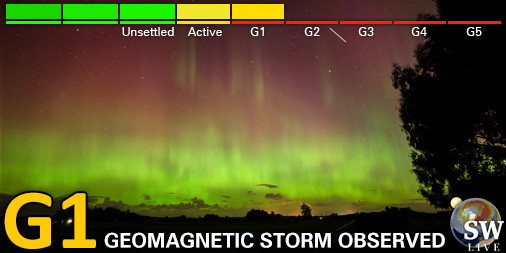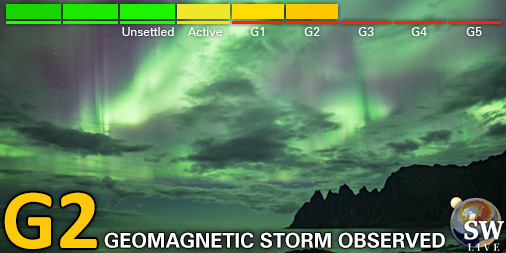Viewing archive of Tuesday, 29 August 2023
Daily bulletin on solar and geomagnetic activity from the SIDC
Issued: 2023 Aug 29 1231 UTC
SIDC Forecast
Solar flares
C-class flares expected, (probability >=50%)
Geomagnetism
Quiet (A<20 and K<4)
Solar protons
Quiet
| 10cm flux | Ap | |
|---|---|---|
| 29 Aug 2023 | 142 | 006 |
| 30 Aug 2023 | 142 | 007 |
| 31 Aug 2023 | 144 | 007 |
Solar Active Regions and flaring
The solar flaring activity was at low levels, with only low-level C-class flares recorded in the past 24 hours. The largest flare was an C2.3 flare, peaking at 23:59 on Aug 28, associated with the AR behind the east limb (N22E87). There are five active regions visible on the disk, a new region rotated over the east limb (NOAA AR 3417). NOAA AR 3415 (beta-delta class) is the most complex region on the disk but was quiet. NOAA AR 3413, that gained complexity from beta to beta- gamma class, produced only low C-class flares. The solar flaring activity is expected to be at low levels over the next 24 hours with C-class flares likely and M-class flares possible.
Coronal mass ejections
There were no Earth-directed Coronal Mass Ejections (CMEs) detected in the available coronagraph observations in the last 24 hours.
Coronal holes
A positive polarity coronal hole in the northern hemisphere transited the central meridian today.
Solar wind
Over the past 24 hours the solar wind parameters were reflecting near slow solar wind conditions. The solar wind speed ranged between 320 - 370 km/s. The interplanetary magnetic field magnitude was below 8 nT. The southward component of the interplanetary magnetic field fluctuated between -6 nT and 7 nT. Similar solar wind conditions are expected to prevail during the next days, with a low chance of a weak enhancement on Aug 30 due to a possible arrival of the CME from Aug 26.
Geomagnetism
Geomagnetic conditions were quiet (NOAA Kp: 1 - 2 and K-BEL: 1 - 2). Geomagnetic conditions are expected to be at mostly quiet levels, with a small chance of increasing to unsettled and active conditions on Aug 30, due to a possible arrival of the CME from Aug 26.
Proton flux levels
Over the past 24 hours the greater than 10 MeV GOES proton flux was at nominal levels and is expected to remain so over the next 24 hours.
Electron fluxes at geostationary orbit
The greater than 2 MeV electron flux, as measured by the GOES-16 satellite, was below the 1000 pfu threshold and is expected to remain below this threshold for the next days.The 24h electron fluence was at normal level. The electron fluence is expected to be at normal levels in the next days.
Today's estimated international sunspot number (ISN): 088, based on 13 stations.Solar indices for 28 Aug 2023
| Wolf number Catania | 097 |
| 10cm solar flux | 142 |
| AK Chambon La Forêt | 010 |
| AK Wingst | /// |
| Estimated Ap | 010 |
| Estimated international sunspot number | 085 - Based on 23 stations |
Noticeable events summary
| Day | Begin | Max | End | Loc | Strength | OP | 10cm | Catania/NOAA | Radio burst types | |
|---|---|---|---|---|---|---|---|---|---|---|
| None | ||||||||||
Provided by the Solar Influences Data analysis Center© - SIDC - Processed by SpaceWeatherLive
All times in UTC
Current data suggests there is a moderate possibility for aurora to appear at the following high latitude regions in the near future
Gillam, MB, Yellowknife, NTCurrent data suggests there is a slight possibility for aurora to appear at the following high latitude regions in the near future
Edmonton, AB, Iqaluit, NU, Saskatoon, SK, Whitehorse, YTNuuk
Juneau, AK
Current data suggests there is a slight possibility for aurora to appear at the following middle latitude regions in the near future
Winnipeg, MBLatest news
Latest forum messages
Support SpaceWeatherLive.com!
A lot of people come to SpaceWeatherLive to follow the Sun's activity or if there is aurora to be seen, but with more traffic comes higher server costs. Consider a donation if you enjoy SpaceWeatherLive so we can keep the website online!

Latest alerts
04:15 UTC - Geomagnetic activity
Minor G1 geomagnetic storm (Kp5) Threshold Reached: 04:05 UTC
03:15 UTC - Geomagnetic activity
Moderate G2 geomagnetic storm (Kp6) Threshold Reached: 02:59 UTC
01:00 UTC - Geomagnetic activity
Minor G1 geomagnetic storm (Kp5) Threshold Reached: 00:51 UTC
Friday, 4 April 2025
23:30 UTC - Geomagnetic activity
Minor G1 geomagnetic storm (Kp5) Threshold Reached: 23:17 UTC
21:03 UTC - Hemispheric Power Index
The OVATION model predicts the Hemispheric Power Index to reach 75GW at 21:49 UTC
Space weather facts
| Last X-flare | 2025/03/28 | X1.1 |
| Last M-flare | 2025/04/01 | M2.5 |
| Last geomagnetic storm | 2025/04/04 | Kp5+ (G1) |
| Spotless days | |
|---|---|
| Last spotless day | 2022/06/08 |
| Monthly mean Sunspot Number | |
|---|---|
| March 2025 | 134.2 -20.4 |
| April 2025 | 148 +13.8 |
| Last 30 days | 130.9 -15.2 |






